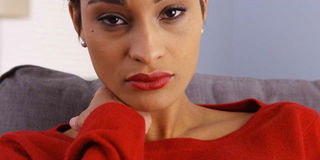DR FLO: Am I too old to have another baby?

I conceived in June 2016, but the father did not want the baby. He gave me something to drink that triggered a miscarriage. PHOTO| FOTOSEARCH
Dr Flo, I am in my mid-forties and I have a 23-year-old daughter. I have been trying to conceive again for 20 years, though I had fibroids. I conceived in June 2016, but the father did not want the baby. He gave me something to drink that triggered a miscarriage. I still cry when I think about losing that pregnancy. Is it too late for me to have another baby? I still get my periods. CM
Dear CM
You can still get pregnant, though a pregnancy in the mid-forties is associated with a higher risk of complications.
Getting pregnant again is usually possible from six weeks after pregnancy loss, but conceiving is not automatic and may take some time. Medical professionals only get concerned when you have been unable to conceive after a year of trying.
You may need to talk to a psychologist/counsellor to help you deal with any psychological issues because severe emotional stress may delay getting pregnant.
Fibroids are non-cancerous growths in or on the uterus. Their effect on the ability to conceive depends on where they are, for example, submucosal fibroids (growing under the lining of the uterus) are more likely to cause problems with conceiving than other types. Many women have been able to conceive even though they have fibroids.
***
Dr Flo, I have keratosis pillaris. I have tried all sorts of skin oils, but the problem persists. How can I get rid of it? Patricia
Dear Patricia,
Keratosis pilaris is a genetic condition that causes small bumps on the skin due to plugging of hair follicles by dead skin cells. The skin may also be dry and itchy.
These bumps are more common on the arms, thighs, cheeks or buttocks, and can worsen due to hormonal changes during puberty and adolescence.
It is a genetic condition, cannot be cured and the symptoms are usually difficult to manage. In some people, it clears without intervention by the age 30.
You can use creams that have urea and lactic acid to soften dry skin and loosen dead skin cells. A dermatologist may prescribe retinol creams, chemical peels, microdermabrasion or laser treatments.
At home, take short, warm baths; moisturise daily; exfoliate daily by gently scrubbing with a loofah or a pumice stone and use coconut oil. Avoid shaving or waxing, and avoid wearing tight clothes because they create friction and irritate the skin.
***
Dr Flo, I have back pain due to slipped discs. I was told not to bend, but it is hard to avoid it because some work requires bending. Is there a permanent solution that doesn’t involve surgery? And how can I relieve the pain? Wambui
Dear Wambui,
The spinal column is made of 33 small bones, called vertebrae, which are stacked on top of each other. Each of those bones has a hole in the middle, so when they are joined together, a canal is formed, which is where the spinal cord carrying all the nerves passes.
At the space between one bone and the next, a nerve leaves the spinal cord, heading to its specific destination e.g. a finger.
Between one bone and the next, there is a cushion called an inter-vertebral disc. If this disc protrudes or bulges out of its specific space, it can press on the nerves that are leaving through that space, or cause the space that the spinal cord is in to become smaller. This is called stenosis.
When this happens, there is back pain and pain along the path that the compressed nerve is taking e.g. to the thigh, leg or foot.
The bulging of the inter-vertebral disc can be caused by wearing out of the disc by disease, or from constant sitting, driving or squatting. Sometimes the disc can bulge due to lifting heavy loads or from sport injuries.
The disc that is bulging cannot be pushed back into place. To manage the pain, use painkillers for a short while when there is a lot of pain; do back exercises with a skilled personal trainer; and go for physiotherapy. Surgery can be done as a last resort.
You should not lift anything beyond your abilities, make sure you get adequate rest after straining, and even with seemingly smaller loads, like a bucket of water, make sure you do not lift while your back is bent. Instead, squat and lift slowly with your back straight and maintain good posture.
***
Send your medical questions to [email protected] for free expert advice


